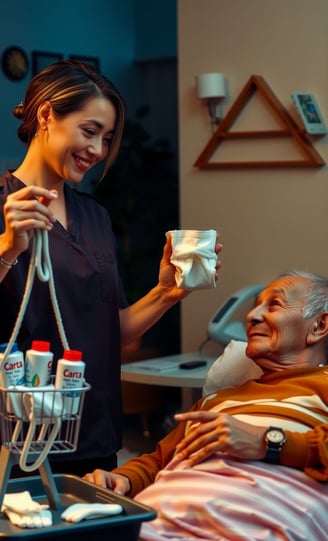
Adult Diaper Changing: Comfort, Techniques, Positioning for Caregivers - A Guide to Best Practices
Explore essential techniques and positioning strategies for adult diaper changing, focusing on comfort and reducing caregiver strain. Discover best practices, including ergonomic tips, step-by-step guides, common challenge solutions, and resources for effective management of bedridden patients.
INCONTINENCE CAREHYGIENE AND PERSONAL CARE
Introduction
Adjusting to the responsibility of changing an adult’s diaper can be a daunting task for many caregivers. This comprehensive guide offers practical solutions to overcome these challenges, emphasizing comfort, proper positioning, and ergonomic techniques that ensure dignity and safety during this intimate daily routine.
"Adult Diaper Changing: Comfort, Techniques, and Positioning for Caregivers - A Guide to Best Practices" is your go-to resource for applying best practices while maintaining a compassionate and effective approach to diaper changing.
Table of Contents


Proper positioning with pillows can make all the difference
The Significance of Comfort During Diaper Changes
Comfort during diaper changes goes beyond physical ease; it's crucial for preventing pressure sores, reducing discomfort for both the caregiver and the care receiver, and upholding dignity—a cornerstone of quality caregiving. When a person is comfortable, they are less likely to experience stress-related complications that can arise from the physical strain of diaper changes.
Essential Positioning Techniques
Proper positioning is vital not only for comfort but also for preventing potential injuries and ensuring safety during these necessary tasks. Here’s how to align, support, and secure a care receiver effectively:
Align Properly: Ensure the spine is straight when positioning your loved one. This alignment helps distribute weight evenly across their body during diaper changes. Proper alignment isn't just about comfort; it’s also a preventative measure against potential injuries.
Support the Body: Utilize pillows and cushions to maintain natural body curves. This can significantly reduce pressure points, especially for bedridden patients or those with limited mobility. Cushioning is a game changer when it comes to preventative care.
Safety Considerations: Always ensure the area around your loved one is clear of hazards and that they are securely fastened or supported during changes. This minimizes fall risks significantly, especially when mobility issues are present. Securing a patient’s position is as crucial to their safety as it is to their comfort.


Use ergonomic techniques to minimize strain during diaper changes
Techniques to Minimize Strain on the Caregiver
Caregivers often face physical strain during diaper changes, but with proper body mechanics and the right tools, this can be significantly mitigated. Here’s how:
Ergonomic Positioning: Adopt a stance that keeps your back straight while bending to reduce the risk of strain. This often involves kneeling or squatting with support when possible, and using tools like raised changing tables. An ergonomically sound position can make all the difference in preventing caregiver fatigue.
Body Mechanics: Master lifting techniques that involve bending at your knees, not your waist, to significantly reduce back strain when moving your loved one for diaper changes or transfers to and from the bed or chair. Correct body mechanics are non-negotiable in caregiving.
Tools and Equipment: Invest time in understanding how lifting aids, transfer belts, or slide sheets can transform the experience for both you and your loved one. These tools not only make transitions smoother but also safer, especially when dealing with limited mobility. The right equipment can make all tasks more manageable.
Step-by-Step Guide to a Comfortable Diaper Change
Creating an environment that fosters comfort and accessibility is the first step toward executing diaper changes with ease:
1. Preparation: Clear out clutter from around your loved one's area, ensuring they have enough space for movement without risk of injury or discomfort. This might involve adjusting the room's temperature and lighting to create a soothing atmosphere conducive to the task at hand.
2. The Diaper Changing Process: Follow these detailed steps, always keeping your loved one's comfort and proper positioning in mind throughout each phase of the diaper change. Handle any undressing with care if necessary, and proceed with the change while maintaining their dignity and your own.
3. Post-Change Care: After the diaper change, reposition your loved one as needed and ensure they are comfortable in their new state of rest or activity. This helps prevent any discomfort from arising post-procedure. Adjust pillows for support if they’ve been lying down for an extended period.
Explaining the process helps reduce anxiety and builds trust


Common Challenges and Solutions
Every caregiver faces unique challenges; here are some common ones along with solutions to keep both parties comfortable:
Limited Mobility: When mobility is limited or resistance occurs, patience combined with gentle persuasion can often pave the way. Maintaining a calm and reassuring demeanor is crucial in these situations. Tools like slide sheets can also be beneficial, helping to assist movement without straining either party involved.
Managing Resistance: Communication is key. Resistance can often stem from discomfort or fear; address these concerns directly and reassure your loved one of their safety. Clearly explain the process to alleviate any anxiety related to diaper changes, making them feel secure by knowing what to expect.
Conclusion: The Importance of Prioritizing Comfort and Proper Positioning in Caregiving
Reflecting on the importance of comfort and proper positioning in caregiving goes beyond physical ease—it contributes to emotional well-being, dignity, and the overall quality of life for those receiving care. By prioritizing these aspects, as you've learned here today, your approach will be more effective in providing the best possible support during diaper changes.
Additional Resources
For additional guidance and resources on adult diaper changing techniques, positioning strategies, ergonomic practices, or managing common challenges faced during the process, consider exploring these reputable sources. Here's an external link to a comprehensive guide that can enhance your skills as a caregiver:
AARP Caregiving Resource Center : Offers tools, tips, and support for family caregivers, including health, safety, legal advice, and a community for sharing experiences.
Family Caregiver Alliance: Supports caregivers with education, advocacy, support groups, and resources on managing stress and caregiving.
Visit National Alliance for Caregiving: Improves family caregivers’ quality of life through research, advocacy, and education, providing information on caregiving trends and best practices.
This training video demonstrates how to change diapers for fully dependent elderly individuals. It was produced by the Centre For Seniors (CFS), a registered non-profit Voluntary Welfare Organisation established in 2006, dedicated to enhancing the overall well-being of seniors in Singapore.
Frequently Asked Questions
Why is comfort so important during adult diaper changes?
Comfort during diaper changes helps prevent pressure sores, reduces discomfort for both parties involved, and maintains dignity – a key aspect of quality caregiving. It also minimizes stress-related complications that can arise from physical strain.
How do I properly position an adult for a diaper change?
Ensure the spine is straight to distribute weight evenly across their body. Use pillows and cushions to maintain natural body curves, significantly reducing pressure points. Always ensure the area around them is clear of hazards and they are securely fastened or supported.
How can I minimize strain on myself as a caregiver during diaper changes?
Maintain an ergonomically sound position by kneeling or squatting with support when possible, using tools like raised changing tables, and mastering lifting techniques that involve bending at your knees instead of the waist. Also, consider using lifting aids, transfer belts, or slide sheets to make transitions smoother and safer.
What steps should I follow for a comfortable adult diaper change?
Preparation: Clear clutter from around their area, adjust temperature and lighting for comfort.
Diaper Changing Process: Follow detailed steps keeping comfort and proper positioning in mind throughout each phase. Handle undressing with care and maintain both parties' dignity.
Post-Change Care: Reposition them as needed, ensure they're comfortable, and adjust pillows for support if they've been lying down.
How do I handle limited mobility or resistance during adult diaper changes?
Limited Mobility: Be patient and use gentle persuasion combined with tools like slide sheets to assist movement without straining either party.
Managing Resistance: Communicate clearly about the process, address concerns directly, reassure them of their safety, and explain what to expect to alleviate anxiety.
Why are comfort and proper positioning important in caregiving?
Prioritizing these aspects contributes to emotional well-being, dignity, and overall quality of life for those receiving care. It makes your approach more effective in providing the best possible support during intimate daily routines like diaper changes.
Related Article
More for you



